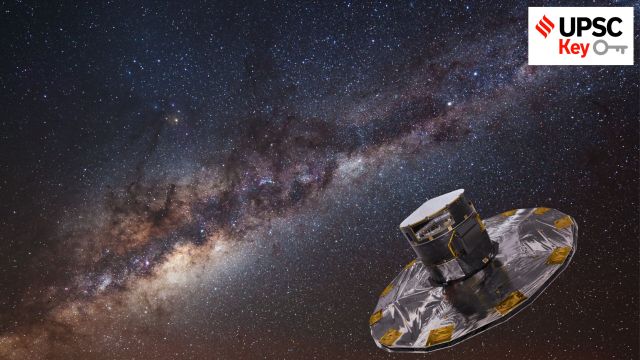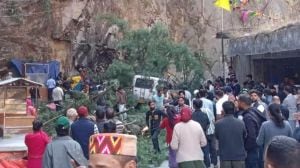UPSC Key: Gaia Mission, Deep Ocean Exploration and Joint Comprehensive Plan of Action (JCPOA)
Why United States and Iran bilateral relations is relevant to the UPSC exam? What is the significance of topics such as Russian President Vladimir Putin’s upcoming visit to India, recent drops in placement rates at IITs and the Immigration and Foreigners Bill, 2025 on both the preliminary and main exams? You can learn more by reading the Indian Express UPSC Key for March 28, 2025.
 UPSC Key March 2025: Here's what you should be reading from the March 28, 2025 edition of The Indian Express (©European Space Agency)
UPSC Key March 2025: Here's what you should be reading from the March 28, 2025 edition of The Indian Express (©European Space Agency)
Important topics and their relevance in UPSC CSE exam for March 28, 2025. If you missed the March 27, 2025 UPSC CSE exam key from the Indian Express, read it here
THE WORLD
Khamenei aide: Iran ready for indirect US talks
Syllabus:
Preliminary Examination: Current events of national and international importance
Main Examination: General Studies II: Effect of policies and politics of developed and developing countries on India’s interests, Indian diaspora.
What’s the ongoing story: Kamal Kharrazi, an adviser to Iran’s supreme leader, said on Thursday Tehran has not closed all doors to resolve its disputes with the United States and is ready for indirect negotiations with Washington.
Key Points to Ponder:
• Know about Joint Comprehensive Plan of Action (JCPOA)
• What was the 2015 Iran nuclear deal?
• United States and Iran bilateral relations-Know in detail
• Why the relations between the United States and Iran, have been especially bitter since 2018?
• What were the terms and conditions agreed by Iran under Joint Comprehensive Plan of Action?
• Revival of the Joint Comprehensive Plan of Action (JCPOA) Under USA President Donald Trump-Why?
• Iran and USA bilateral relations-what implications could this have for India?
• Why Iran is important for US?
Key Takeaways:
• Tehran has so far rebuffed U.S. President Donald Trump’s warning it to make a deal or face military consequences.
• Supreme Leader Ayatollah Ali Khamenei called the message deceptive and Foreign Minister Abbas Araqchi said talks are impossible unless Washington changes its “maximum pressure” policy.
• “The Islamic Republic has not closed all doors. It is ready for indirect negotiations with the United States in order to evaluate the other party, state its own conditions and make the appropriate decision,” Kharrazi said, according to the semi-official Iranian Students News Agency.
• Iran is meant to soon reply to Trump’s letter, with Araqchi saying last week that Tehran would take into consideration both Trump’s threat and opportunities in its response.
Do You Know:
• In his first 2017-21 term, Trump withdrew the U.S. from a 2015 deal between Iran and world powers that placed strict limits on Tehran’s disputed nuclear activities in exchange for sanctions relief.
• After Trump pulled out in 2018 and reimposed sweeping U.S. sanctions, the Islamic Republic breached and has since far surpassed those limits in its escalating programme of uranium enrichment.
• Western powers accuse Iran of having an clandestine agenda to develop nuclear weapons capability by enriching uranium to a high level of fissile purity, above what they say is justifiable for a civilian atomic energy programme.
• In 2015, the five permanent members of the UN Security Council, Germany, the European Union, and Iran signed the ‘Joint Comprehensive Plan of Action’ (JCPOA), more commonly known as the Iran nuclear deal. The Obama-era deal provided Iran with sanctions relief in return for Tehran severely limiting the scope of its nuclear program — Iran agreed to not enrich its uranium beyond 3.67%, a level suitable for peaceful nuclear power applications but not for weapons production — and signing a roadmap agreement with the International Atomic Energy Agency (IAEA).
• Tehran says its nuclear programme is wholly for civilian energy purposes
Other Important Articles Covering the same topic:
📍Why Trump withdrew from the Iran nuclear deal in 2018, and why he wants to renegotiate now
Previous year UPSC Prelims Question Covering similar theme:
1. Which of the following is not a member of ‘Gulf Cooperation Council’? (2016)
(a) Iran
(b) Saudi Arabia
(c) Oman
(d) Kuwait
FRONT PAGE
Putin will visit India; we share call for talks on Ukraine: Russia
Syllabus:
Preliminary Examination: Current events of national and international importance.
Main Examination: General Studies II: Bilateral, regional and global groupings and agreements involving India and/or affecting India’s interests.
What’s the ongoing story: Praising the Indian government and Prime Minister Narendra Modi for “consistently” taking a “balanced position on the Ukrainian crisis” and for advocating its “resolution through dialogue”, Russian Foreign Minister Sergey Lavrov said Thursday that President Vladimir Putin will visit India this year and preparations for it are underway.
Key Points to Ponder:
• Analyse the Russian President Vladimir Putin’s upcoming visit to India in the context of the present geopolitical scenario.
• India has maintained a balanced diplomatic position on the Russia-Ukraine conflict—discuss
• Evaluate the role of India and Russia in shaping the future of multilateral forums like BRICS and the Shanghai Cooperation Organisation (SCO).
• India and Russia relations—know the background
• The India-Russia economic partnership is evolving—What are the prospects and challenges of increasing bilateral trade through alternative payment mechanisms?
Key Takeaways:
• This will be Putin’s first visit to India after the Russian invasion of Ukraine in February 2022. The announcement of the visit comes at a time when US President Donald Trump has taken the lead in mediating a ceasefire between the Kremlin and Kyiv. Trump is also expected to visit India for the summit of Quad leaders later this year.
• In a video address to a conference titled ‘Russia and India: Together Towards a New Bilateral Agenda’ in Moscow, Lavrov said, “It is symbolic that Prime Minister Modi made his first bilateral foreign visit after his re-election last year to Russia. Now it is our turn. Russian President Putin has accepted the invitation of the head of the Indian government. The visit of the head of the Russian state to the Republic of India is being prepared.”
• The visit is part of a protocol between India and Russia for reciprocal annual visits by their leaders. However, once the Ukraine war began, the visits stopped, and resumed only in July last year when Modi travelled to Moscow with the message that “a solution cannot be found on the battlefield”.
Do You Know:
• The Russian invasion of Ukraine in February 2022 did put India in a diplomatic pickle, but Delhi has been one of the few Capitals regularly talking to both the Kremlin and Kyiv at various levels, maintaining that the two sides need to do direct negotiations and find a way out of the crisis.
• In July last year, while thanking Putin for the “gracious hospitality” extended to him and his delegation, Modi invited him to visit India in 2025 for the 23rd India-Russia Annual Summit, the Ministry of External Affairs had said then.
• Modi also travelled to Kyiv last August and met Ukraine President Volodymyr Zelenskyy, asking him to sit with Putin to “find a way out of the crisis”.
• He visited Russia again in October, this time for the BRICS Summit in Kazan. He has also been invited to the Russian Victory Day celebrations in May this year – there is no official word from Delhi so far on the likelihood of his visit to Moscow.
Other Important Articles Covering the same topic:
📍5 ways in which India-Russia relationship will shape the world in 2025
Previous year UPSC Prelims Question Covering similar theme:
2. Recently, India signed a deal known as ‘Action Plan for Prioritization and Implementation of Cooperation Areas in the Nuclear Field’ with which of the following countries? (2019)
(a) Japan
(b) Russia
(c) The United Kingdom
(d) The United States of America
Previous year UPSC Mains Question Covering similar theme:
📍What is the significance of Indo-US defence deals over Indo-Russian defence deals? Discuss with reference to stability in the Indo-Pacific region. (2020)
Over half of IITs saw 10 percentage point drop in placement since ’21-22: Govt data
Syllabus:
Preliminary Examination: Economic and Social Development-Sustainable Development, Poverty, Inclusion, Demographics, Social Sector Initiatives, etc.
Main Examination: General Studies II: Issues relating to development and management of Social Sector/Services relating to Health, Education, Human Resources.
What’s the ongoing story: In more than half of the country’s 23 Indian Institutes of Technology (IITs), placements for BTech students dropped by more than 10 percentage points in 2023-24 compared to 2021-22, according to the first such disclosure of data by the union government.
Key Points to Ponder:
• Analyse the recent drops in placement rates at IITs.
• What factors could be contributing to drops in placement rates at IITs?
• How economic slowdown impact campus placements in premier institutions like IITs?
• Despite being centres of excellence, IITs face placement challenges in certain disciplines—Why?
• Know the role of government initiatives such as ‘Make in India’ and ‘Digital India’ in improving employment prospects for IIT graduates.
Key Takeaways:
• Barring IIT (BHU) Varanasi, 22 of the 23 IITs have seen a drop in placements in 2023-24 compared to 2021-22, going by information provided by the union government to the Parliamentary Standing Committee on Education, Women, Children, Youth and Sports.
• In its report on the Department of Higher Education’s demand for grants 2025-26, the Parliamentary Standing Committee headed by Congress MP Digvijaya Singh noted that there is an “unusual decline” in placements in IITs and IIITs between the year 2021-22 and 2023-24.
• Among the IITs that saw a drop of more than 10 percentage points in BTech placements in 2023-24 compared to 2021-22, were the older IITs – Madras (drop of 12 percentage points, from 85.71% to 73.29%); Bombay (drop of around 13 percentage points, from 96.11% to 83.39%);
Kanpur (drop of 11 percentage points, from 93.63% to 82.48%); Delhi (drop of around 15 percentage points, from 87.69% to 72.81%).
• In 2021-22, the percentage of students who secured jobs out of those who appeared for placements ranged from 83.15% at IIT Varanasi to 98.65% at IIT Goa, with 14 of the 23 IITs recording over 90% placements.
• In 2023-24, only three IITs – Jodhpur, Patna, and Goa – recorded over 90%, with the highest percentage of 92.98% at IIT Jodhpur and the lowest of 65.56% at IIT Dharwad.
• The sharpest drop was at IIT Dharwad where placements fell by around 25 percentage points in 2023-24 vs 2021-22 (90.20% to 65.56%), followed by IIT Jammu (92% to 70%).
• The country’s oldest IIT, at Kharagpur, saw the smallest drop (of 2.88 percentage points) among the 22 institutes – from 86.79% to 83.91%).
Do You Know:
• While the committee’s report pointed to a similar trend in NITs, and a decline in the average financial package secured by each student placed between 2022-23 and 2023-24, the corresponding data was not included.
• While the IITs refused to comment on the record, students and teachers associated with the campus hiring process attributed the drop to a combination of factors: the aftereffects of post–Covid mass hiring in 2022, a slowdown in key sectors like tech and software, and increasing batch sizes.
• “In 2022, there was a spike in placement percentages as the market recovered after Covid, with rates exceeding 85 per cent. This spike followed a two-year hiring freeze. Hiring in 2023 was more conservative, with fewer top MNCs coming in and a decline in software and tech recruitment. Placements this year might improve over last year, but are unlikely to match 2022 levels. The numbers may normalise by 2025,” said a source from IIT Kanpur.
• Another person associated with placements at IIT Kharagpur pointed to growing batch sizes as a factor. At IIT Kharagpur, the number of students registering for placement has increased from 1,757 in 2018–19 to 2,668 in 2023–24, while those placed grew from 1,375 to 1,662 during the same period.
• Though the placement percentage at IIT Bombay dropped from 82.16 per cent in 2022-23 to 74.53 per cent in 2023-24, an official said it would be misleading to draw conclusions solely from this data as it only reflects on-campus placements and no other career paths. “Many students shown as ‘not placed’ take routes like higher education or off-campus placements or entrepreneurship. The dip does not offer a true reflection unless compared with the exit survey,” the official said.
• A newly introduced exit survey revealed that from 2018 to 2022, 57.1 per cent of students were placed through campus placements, 10.3 per cent found jobs independently, 1.6 per cent initiated start-ups, 8.3 per cent entered public services, 6.1 per cent were still seeking jobs, and 12 per cent pursued higher education in India or abroad.
Other Important Articles Covering the same topic:
📍Why are IIT placements falling? Students look for higher education, civil services
IN PARLIAMENT
‘India not dharamshala’: Shah says action against those coming to create conflict
Syllabus:
Preliminary Examination: Indian Polity and Governance
Main Examination: General Studies II: Government policies and interventions for development in various sectors and issues arising out of their design and implementation.
What’s the ongoing story: Union Home Minister Amit Shah Thursday said that those who come to India for development are welcome but strong action will be taken against those coming to “create conflict” as the Lok Sabha passed the Immigration and Foreigners Bill, 2025, aimed at regulating immigration, entry, and stay of foreigners in India, by a voice vote.
Key Points to Ponder:
• The Immigration and Foreigners Bill, 2025-Know key features
• Discuss the contentious provisions of the proposed Immigration and Foreigners Bill, 2025
• Do you think that immigration bill can tackle passport fraud and illegal immigration?
• What can be the short term and long term implications of illegal immigration in India?
• What steps should the government take to strengthen border control and immigration laws?
• Examine the role of biometric passports and e-visas in enhancing immigration security.
• How can technology like AI can be used to help prevent fake passport usage?
• The Immigration (Carriers’ Liability) Act, 2000, and three pre-independence laws, the Passport (Entry into India) Act, 1920, the Registration of Foreigners Act, 1939, and the Foreigners Act, 1936—what you know about the same
Key Takeaways:
• Replying to a debate on the Bill, Shah said, “To bolster national security and economy, to make our universities global, to lay the foundation for R&D, and to make this country the best in 2047, this Bill is very important… Whoever enters our territory, when, for what time period, and with what intent, it is important for us to know. We will track in detail the entry of each foreigner in India.”
• “Parsis came to India from Persia and are safe here. If there is one smallest minority that stays with self-respect anywhere, it is here. Jews also came from Israel to India. Through CAA, we opened the doors for persecuted minorities,” he said.
• “Under Section 3, there is a provision for denying entry to someone who is a threat to national security. This country is not a dharamshala. Now the blacklist has a legal backing,” Shah said.
• Being the fifth largest economy in the world, people coming to the country is natural, Shah said. “We welcome those who come for developing India, but be it Rohingya or Bangladeshi, if they come to create conflict here, we will act tough against them,” Shah said.
Do You Know:
• The Bill mandates registration of foreigners arriving in India, empowers the Centre to disallow a foreigner entry to India or exit from India, and to decide what kind of activity the foreigners shall not engage in. The keepers of accommodations, say hotels, and authorities of universities and hospitals, will be mandated to provide online information regarding the stay of foreigners. The onus to prove that the person is not a foreigner will under the Bill lie with the one suspected to be a foreigner.
• The Bill repeals and replaces the Immigration (Carriers’ Liability) Act, 2000, and three pre-independence laws, the Passport (Entry into India) Act, 1920, the Registration of Foreigners Act, 1939, and the Foreigners Act, 1936.
• The Statement of Objects and Reasons submitted alongside the Bill mention that the Acts “are not only of pre-Constitution period, but also, they were brought into extraordinary times of first and second world wars”. It also notes that there are overlapping provisions and that there is a necessity to enact a comprehensive legislation.
• The Bill would establish an overarching Bureau of Immigration (Section 5) with a Commissioner at its head, who will be assisted by Foreigners Regional Registration Officers, Foreigners Registration Officers, Chief Immigration Officers and other Immigration officers designated by the Centre. The Bureau will fall under the Centre and will be in charge of performing “immigration functions” such as regulating the entry and exit of foreigners along with any other functions that the Centre prescribes.
• It would also empower the Central government to pass orders or directions regarding foreigners (Section 7) including:
—Requirements for foreigners to enter and depart India “only at such times and by such route and at such port or place”, subject to any specified “conditions on arrival”;
—Order that a foreigner shall not remain in India or in any “specified area” within India;
—Order that a foreigner shall “remove himself to, and remain in” a specified area within India, or reside in a particular place;
—Requiring them to present herself for examination to furnish information “in such manner, at such time, as may be required”;
—Requiring them to furnish proof of identity;
—Requiring them to submit biometric information and handwriting/signature samples;
—Requiring them to submit to a medical examination;
—Prohibiting them from associating with “persons of a specified description”;
—Prohibiting them from engaging in “activities of a specified description”;
—Prohibiting them from “using or possessing specified articles”;
—If a foreigner is ordered to reside in a certain area, they will also be subject to any conditions imposed by the Centre regarding “maintenance, discipline and the punishment of offences and breaches of discipline” (Section 13).
—Foreigners who overstay their visa or violate any orders under Section 7 can be punished with up to three years imprisonment and a fine of up to Rs 3 lakh (Section 23).
• The Bill also carries punishments for foreigners who:
—Enter any area without a valid passport or a travel document (Section 21). The punishment is up to five years imprisonment and/or a fine of up to Rs 5 lakh.
—Use a forged or fraudulently obtained travel document or visa to enter, reside or exit India (Section 22). This is punishable with 2-7 years imprisonment and/or a fine of Rs 1-10 lakh.
—Universities, educational institutions, and medical institutions are also required to furnish information to the government in case foreigners are admitted (Sections 9 & 10).
—The Bill also empowers the Centre to exert control over places that are “frequented by any foreigner” and require the owner to close the premises, permit its use under specified conditions, or refuse admission to all or a “specified class” of foreigners (Section 14).
• A carrier has been defined as a person or entity “engaged in the business of transporting passengers or cargo by air, water or land by aircraft or ship or any other mode of transport”.
Other Important Articles Covering the same topic:
📍Immigration and Foreigners Bill, 2025 in Parliament: Its provisions, criticism
Previous year UPSC Mains Question Covering similar theme:
📍“Refugees should not be turned back to the country where they would face persecution or human right violation.” Examine the statement with reference to the ethical dimension being violated by the nation claiming to be democratic with open society. (2021)
GOVT & POLITICS
Centre increases NREGS wages by 2-7% for FY26
Syllabus:
Preliminary Examination: Economic and Social Development
Main Examination: General Studies II: Important aspects of Governance and Welfare schemes for vulnerable sections of the population by the Centre and States and the performance of these schemes
What’s the ongoing story: The Centre has hiked the wages under the Mahatma Gandhi National Rural Employment Guarantee Scheme (MGNREGS) in the range of 2-7% for the financial year 2025-26.
Key Points to Ponder:
• The recent wage hike by Centre under MGNREGS is expected to have both economic and social implications—Know the impact of this revision on rural employment.
• Discuss the role of MGNREGS in reducing rural unemployment.
• How can the MGNREGS scheme can be reformed to enhance its efficiency and long-term sustainability?
• Despite being one of the world’s largest employment programs, MGNREGS faces challenges such as delayed wage payments and fund shortages—why?
• ‘Higher MGNREGS wages may influence labour mobility patterns and rural inflation’—How far you agree with the given statement?
• MGNREGS has been a critical tool in addressing income inequality and social security in rural India. Evaluate its effectiveness especially in the post-pandemic period.
Key Takeaways:
• The Ministry of Rural Development (MoRD), which is the nodal ministry to run the rural job guarantee programmes, on Thursday issued a notification revising the NREGS wages for the FY 2025-26.
• In absolute terms, the NREGS wages have seen a hike in the range of Rs 7 to Rs 26. The NREGS wages have been hiked by ₹7 in five states, Andhra Pradesh, Arunachal Pradesh, Assam, Nagaland, and Telangana. The highest increase of Rs 26 has been recorded in Haryana, where NREGS wages will touch the Rs 400-mark during 2025-26 from its current rate of Rs 374 per day. This will be first time the NREGS wages will touch Rs 400 per day in any state.
• The government notifies the NREGS wage rates under sub-section (1) of Section 6 of the Mahatma Gandhi National Rural Employment Guarantee Act, 2005. The new rates become effective from the 1st day (April 1) of the financial year.
• The NREGS wage rates are fixed according to changes in the CPI-AL (Consumer Price Index for Agricultural Labourers), which reflects the increase in inflation in rural areas.
• In the current financial year (2024-25), Goa had seen the maximum hike of 10.56% over its previous year (2022-23) wage rate; Uttar Pradesh and Uttarakhand recorded the lowest 3.04%.
Do You Know:
• Under MGNREGA, every rural household, whose adult members volunteer to do unskilled manual work, is entitled to get at least 100 days of wage employment in a financial year.
• While Section 3 (1) of MGNREGA provides for “not less than 100 days” work per rural household in a financial year, it has become de facto upper limit as the NREGA software does not allow data entries for employment above 100 days to a household unless specifically requested by the State/UT.
• In some cases the government allows additional 50 days of wage employment (beyond the stipulated 100 days). For instance, every Scheduled Tribe household in a forest area is entitled to get 150 days of work under NREGS, provided that such families have no other private property except for the land rights granted under the Forest Right Act, 2016.
• Besides, the government, under Section 3(4) of MGNREGA, can also provide an additional 50 days of unskilled manual work in a financial year in such rural areas where drought or any natural calamity (as per Ministry of Home Affairs) has been notified.
Other Important Articles Covering the same topic:
📍Budget 2023 cuts MGNREGS funds: The debate around the rural employment scheme
Previous year UPSC Mains Question Covering similar theme:
2. Among the following who are eligible to benefit from the “Mahatma Gandhi National Rural Employment Guarantee Act”? (UPSC CSE 2011)
(a) Adult members of only the scheduled caste and scheduled tribe households
(b) Adult members of below poverty line (BPL) households
(c) Adult members of households of all backward communities
(d) Adult members of any household
EXPLAINED
Syllabus:
Preliminary Examination: Current events of national and international importance.
Mains Examination: General Studies III: Achievements of Indians in science & technology; indigenization of technology and developing new technology.
What’s the ongoing story: Last month, India completed wet testing of its Matsya-6000 submersible, capable of diving up to 6 km below the surface to look for underwater minerals off the coast. The launch of the first deep-sea manned vehicle is planned for later this year — it will put India in a select group of nations with the capability to send humans to these depths.
Key Points to Ponder:
• What is samudrayaan Mission?
• Discuss the key features of samudrayaan Mission.
• What are the major achievements in Deep Ocean Mission so far?
• Deep Ocean Exploration—What are the issues and challenges associated with it?
• ‘India’s Deep Ocean Mission, including the Samudrayaan project, is crucial for ensuring resource security’-Evaluate
• Discuss the role of policies like the Deep Ocean Mission in advancing India’s blue economy and securing its maritime interests.
Key Takeaways:
• Last week, China unveiled a compact deep sea cable-cutting device that can be mounted on certain submersibles — and which is capable of severing the world’s most fortified underwater communication or power lines. China reportedly operates the largest fleet of submersibles in the world.
• The intense oceanic activity around the world over the past two decades has focused on the Deep both for its economic resources and as the theatre of possible future conflicts.
• According to the United Nations Convention on the Law of the Seas (UNCLOS), the Exclusive Economic Zone (EEZ) of a country extends from the baseline of its coast to 200 nautical miles (about 370 km) into the sea. A nation has exclusive rights to living and non-living resources in the waters and on the seabed within its EEZ.
• Average depth in the Indian EEZ is 3,741 metres — this is more than four-and-a-half times the height of Burj Khalifa, the world’s tallest building. But it is shallow compared to the deepest ocean — the bottom of the Challenger Deep in the Mariana Trench in the western Pacific lies more than 10 km under the surface, more than the cruising altitude of most aircraft.
• Operating in the deep sea requires a distinct technology and extremely specific capabilities that are challenging and expensive to develop. Consider:
—While sound can travel long distances underwater, its propagation is seriously affected by hydrological conditions such as temperature, pressure, and salinity. Generally speaking, the lower the frequency of the sound wave, the better the propagation of sound underwater.
• Very low frequency (VLF) and extremely low frequency (ELF) sound technologies represent the cutting edge of science, and require deep research and enormous funding to develop.
—Pressure underwater increases by approximately one atmosphere (atm) for every 10 metres of ocean depth. One atm is roughly equivalent to the mean sea-level atmospheric pressure on Earth, or 101,325 Pascals. The pressure at the ocean bed in the Indian EEZ is upwards of 380 atm, or 380 times that on the surface of the Earth.
—Vessels that descend to such depths need to be constructed using particular material and processes in order for them to operate safely.
Do You Know:
• To be able to ride on the blue economy in the future, India must have the technologies to harness the resources of the ocean and the seabed.
• The ocean is a storehouse of resources, from fish, minerals, gas hydrates, oil and gas, and nutraceuticals to oceanographic data that may help in combating climate change and contribute to meteorological research. It is essential to harness these resources to maximise India’s economic potential.
• This will require the development of technologies for hydrographic research and exploration activity, as well as supporting capabilities such as diving, salvage, and submarine rescue.
• Then there is the development of underwater infrastructure. Undersea cables crisscrossing the oceans are the backbone of modern communications technology. They are responsible for transmitting more than 95% of the intercontinental Internet traffic, seamlessly enabling activities from digital communication and transmission of video to banking transactions worth billions of dollars.
• Developing the capability to lay and maintain these cables is critical to provide millions of Indians with digital connectivity, and to sustain an economy that increasingly relies on the same.
• As for every niche technology, the essential prerequisites for developing deep sea tech are financial strength, academic and research capabilities, and highly qualified and skilled human capital.
• It is not surprising, therefore, that China, France, Japan, Norway, Russia, South Korea, and the US are far ahead of the rest of the world in this area. Chinese investments in deep sea science and engineering centres are paying rich dividends today.
In 2018, the Indian government launched the Deep Ocean Mission under the Ministry of Earth Sciences. The development of the Matsya-6000 submersible is a part of this mission. While this is welcome, the fact is India currently does not have even decent deep sea fishing capability — and needs to do much more.
Other Important Articles Covering the same topic:
📍In a first, image of active underwater hot spring captured in Southern Indian Ocean
Previous year UPSC Mains Question Covering similar theme:
📍Defining blue revolution, explain the problems and strategies for pisciculture development in India. (2018)
Gaia, European spacecraft that mapped the Milky Way for a decade, shuts down
Syllabus:
Preliminary Examination: Current events of national and international importance.
Main Examination: General Studies III: Awareness in the fields of IT, Space, Computers, robotics, nano-technology, biotechnology and issues relating to intellectual property rights.
What’s the ongoing story: The European Space Agency (ESA) shut down its space observatory mission, Gaia on Thursday (March 27). Launched into space over a decade ago, Gaia has been instrumental in charting the Milky Way galaxy, revealing its past and estimating its future.
Key Points to Ponder:
• What is Gaia Mission?
• What is the significance of the Gaia space mission?
• How has space observatory mission, Gaia’s, data reshaped the understanding of the Milky Way?
• Missions like Gaia play a crucial role in mapping celestial bodies—How?
• What are the key technological innovations that enabled Gaia to achieve unprecedented accuracy in astronomical mapping?
• The retirement of the Gaia mission marks the end of an era in space cartography—Discuss
• With the increasing role of international space agencies in deep space exploration, discuss how global collaboration in astronomical
research can enhance understanding of the universe.
Key Takeaways:
• Gaia was launched in December 2013 aiming to create the most precise, three-dimensional map of the galaxy. It began taking observations on July 24, 2014, finally shutting its eyes on January 15, 2025. Over the last decade, Gaia has taken 3 trillion observations of 2 billion stars and objects and helped inform at least 13,000 scientific publications.
• Gaia was positioned in the Lagrange point 2 (L2), around 1.5 million kilometres ‘behind’ the Earth, when viewed from the Sun. This effectively allows the spacecraft to view the larger cosmos unhindered by the planet, the Sun and the Moon.
• As it twirls in space, twin telescopes, placed in different directions, direct light onto a single digital camera with nearly a billion pixels, making it the largest flown in space. The spacecraft is fitted with three instruments – an astrometer, a photometer and a spectrometer – that help interpret the location and motion of stars and other objects.
• Gaia has transformed the way the Milky Way galaxy is viewed. Its data allowed scientists to recreate not just a 3-D map of the galaxy, but also how it will change over time.
• According to Professor Chris Lintott, a British astrophysicist and professor at the University of Oxford, the ripples produced by these collisions still exist and may have resulted in the formation of stars, including the Sun. “This shows how Gaia is revealing that the Milky Way’s history is both more dynamic and more complex than we thought,” he stated in a lecture at Gresham College on February 26.
Do You Know:
• After the mission shuts its space eyes, scientists have been conducting tests to assess the behaviour of technologies after spending 10 years in space, and help build future missions.
• A bulk of Gaia’s data is yet to be processed. Scientists at the ESA have been actively downlinking all the data collected by the spacecraft over the years, which will be released in the coming years, leading to more discoveries.
• The ESA has said that a part of the remaining data will be released next year, which will cover the mission’s first five-and-a-half years. Another set of data will be released at the end of this decade.
• Despite its scope and magnitude, Gaia would have mapped just about 2% of the 100 billion stars in the galaxy, leaving much to be explored.
Other Important Articles Covering the same topic:
📍GAIA, THE EUROPEAN CARTOGRAPHER OF THE COSMOS, NOW RETIRED
|
PRELIMS ANSWER KEY |
|
1. (a) 2.(d) |
For any queries and feedback, contact priya.shukla@indianexpress.com
Subscribe to our UPSC newsletter. Stay updated with the latest UPSC articles by joining our Telegram channel – IndianExpress UPSC Hub, and follow us on Instagram and X.
Must Read
Buzzing Now



Mar 30: Latest News
- 01
- 02
- 03
- 04
- 05
























